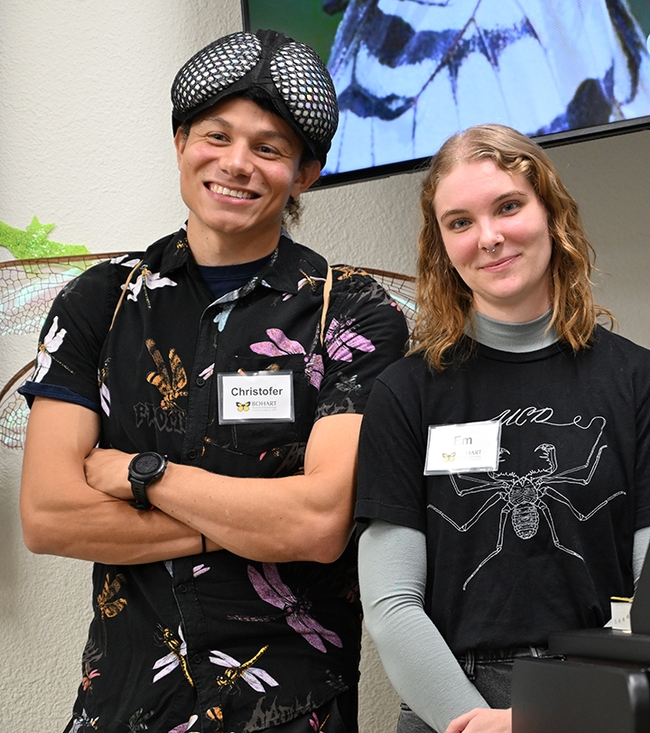
The free and family-friendly event, themed "Specialized Predators of Insects” and held Nov. 2, spotlighted Brothers and his dragonfly research, and Jochim, her spider research.
“Predators (throughout nature) employ two broad strategies: active, and sit-and-wait (ambush)," Brothers said. “When they're actively pursuing prey, they usually rely on speed or endurance. When they wait for prey, they usually rely on stealth, luring or surprise.”
Many predators, such as wasps and snakes, use "capture adaptations, but others physically subdue prey,” he told the crowd, showing a slide of a praying mantis eating a spotted lanternfly and a lion taking down a water buffalo.
Brothers, a member of the Stacey Coombs lab, Department of Neurobiology, Physiology and Behavior, College of Biological Sciences, said he is particularly interested “in the interplay between capture tools and behavioral tactics of predators, specifically in the suborder Anisoptera, the dragonflies.”
Jochim, a member of the Jason Bond lab, UC Davis Department of Entomology and Nematology, studies trapdoor spider evolution and systematics.
The duo jointly narrated a slide show featuring various predators.
In discussing specialist vs. generalist predators, Jochim said “Specialists eat only one or a few types of prey. Many things eat insects, birds, bats, cats, lizards, even plants (carnivorous plants). Some of most effective are arthropods. And few are better than dragonflies and arachnids.”
“What are arachnids? Spiders, scorpions, ticks, camel spiders, whip scorpions and more,” she said, adding that arachnids have “eight legs and most arachnids are predacious."
Predatory arachnids can be big or small, she told the crowd. “A whip spider has a leg span of 8 centimeters, a Goliath birdeater tarantula has a leg span of 20 centimeters, a pseudoscorpion is as small as 2 millimeters, and mites are as small as 1 millimeter.”
Jochim mentioned that spiders make venom to poison or paralyze their prey, and some spiders use silk to capture their prey. “It's sticky, like glue,“ she said, “and works like Velcro.”
On the other hand, whip scorpions (arachnids belonging to the order Uropygi) have no venom. They spray an acidic mix that has a vinegar-like smell.
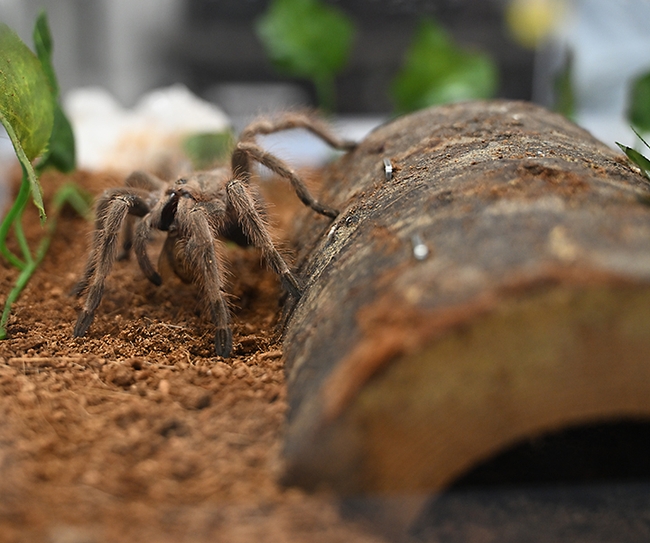
“Dragonflies are incredibly successful predators,” Brothers said. "The adults catch prey up to 97 percent of the time." He displayed images of three dragonflies: Eastern pondhawk, Erythemis simplicicollis; the dot-tailed white ace, Leucorrhinia intacta; and the blue dasher, Pachydiplax longipennis.
“Adult dragonflies specialize in flying prey and utilize both predator strategies: sit-and-wait, and active," Brothers pointed out. "Damselflies hunt both flying and grounded prey. They employ only the sit-and-wait strategy."
Brothers shared that dragonflies "have nearly 360-degree vision, and are extra sensitive to small wavelengths.” Scientists say that dragonflies (and bees) have the largest compound eyes of any insect, with each containing up to 30,000 facets. The eyes cover most of a dragonfly's head; the eyes resemble a motorcycle helmet.
Following their presentations, the doctoral candidates displayed specimens and informational materials and fielded scores of questions. Jochim displayed her three tarantulas and showed how they fluoresce under an ultraviolot (UV) light. The guests delighted in "feeding time," when she fed them crickets.
The Bohart Museum, located in Room 1124 of the Academic Surge Building, 455 Crocker Lane, UC Davis campus, houses a global collection of eight million insects, plus a live petting zoo, and an insect-themed gift shop.
Open houses are held periodically throughout the academic year. Director is Professor Jason Bond, the Evert and Marion Schlinger Endowed Chair, UC Davis Department of Entomology and Nematology; associate dean, UC Davis College of Agricultural and Environmental Sciences; and president-elect of the American Arachnological Society.
More information on the Bohart Museum is available on its website at https://bohart.ucdavis.edu or by contacting bmuseum@ucdavis.edu.
Attached Images:
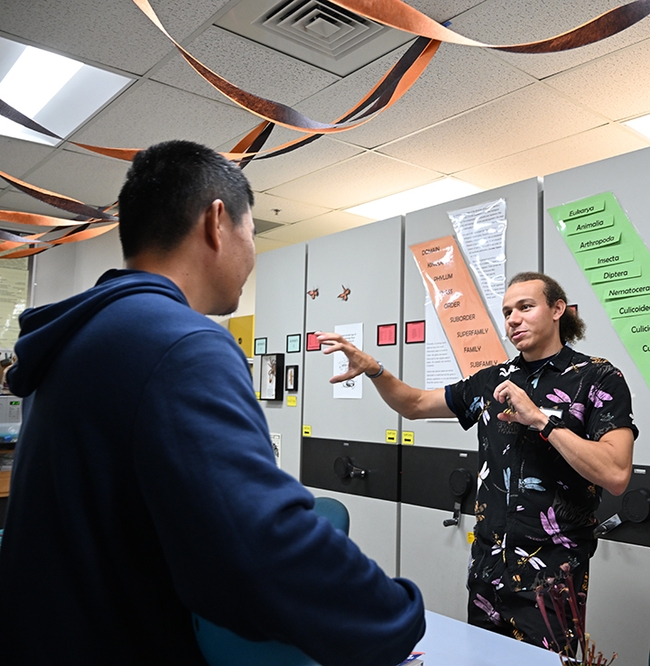
Doctoral candidate Christofer Brothers explains how a dragonfly catches prey. (Photo by Kathy Keatley Garvey)
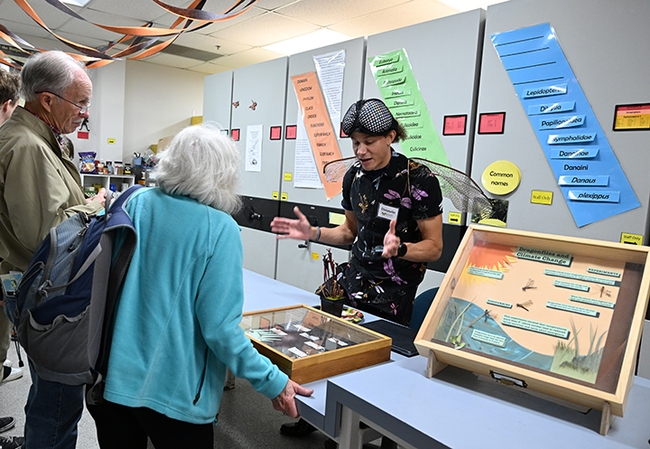
Doctoral candidate Christofer Brothers fielding questions about dragonflies. (Photo by Kathy Keatley Garvey)
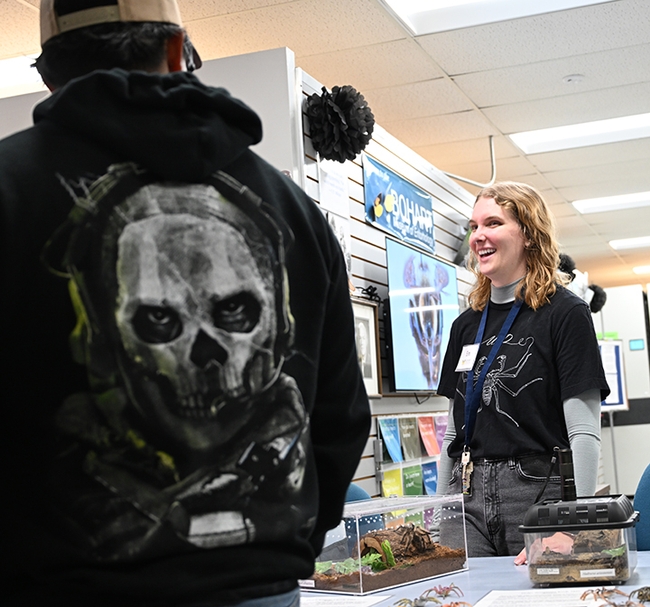
Doctoral candidate Emma "Em" Jochim answers a question about spiders. (Photo by Kathy Keatley Garvey)
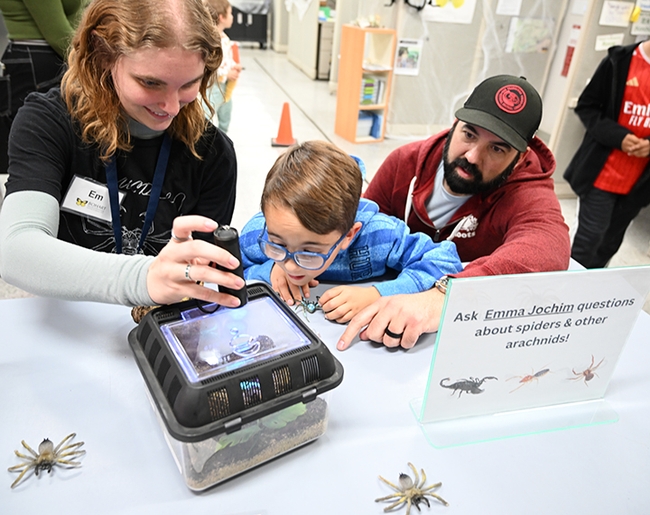
Placerville residents Sullivan Lowe, 6, and his father, Ron Lowe watch as UC Davis doctoral candidate Emma "Em" Jochim fluoresces a tarantula with ultraviolet (UV) light. Sullivan is holding a plastic spider that Jochim gave him. (Photo by Kathy Keatley Garvey)